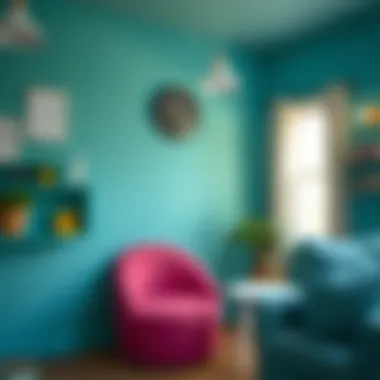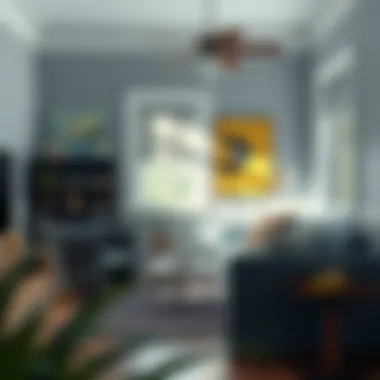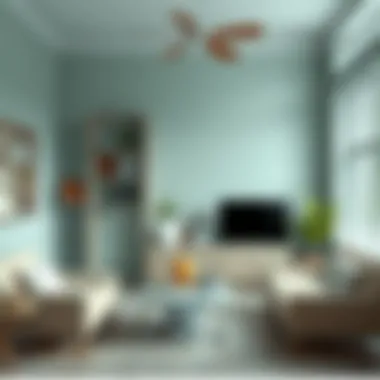Exploring Paint Identification Apps for Home Projects


Intro
Today’s world of home decor is buzzing with creativity. From employed decorators to ambitious home DIYers, everyone is looking to freshen up their space. Among the useful tools that are now at one's disposal are paint identifying apps. These applications not only simplify the selection process of paint colors but also add a spark of inspiration to any home project.
Navigating through the myriad hues and shades available can feel like searching for a needle in a haystack. With various tones and finishes clamoring for attention, it can become quite overwhelming. However, with the rise of paint identifying apps, things are starting to look up. They provide an efficient way to discover, compare, and select the perfect colors, transforming one’s dream project into a tangible reality.
Whether you’re updating a room or excitedly planning a garden shed's makeover, understanding these apps can truly enhance the overall decorating experience. Let’s dive into this world and uncover the significance of paint identifying apps for any decorating task.
Key Insights and Trends
Current Trends in Interior Design
Recent years have seen a shift in interior design trends, with an increasing emphasis on personalization and bold choices. People aren't just applying neutral colors; they’re embracing vibrant shades that express individualism. This shift is supported by paint identifying apps, which allow users to easily experiment with daring colors before committing to a decision.
Some noteworthy trends include:
- Earthy Tones: Rich olive greens, terracotta, and warm browns are making waves, resonating with nature.
- Bold Patterns: Stripes or geometric designs adding character to otherwise plain walls.
- Accent Walls: Selecting one wall to pop in color, creating a focal point without overwhelming the space.
As homeowners look to inject personality into their homes, these trends make identifying the right paint more crucial than ever.
Popular Painting Techniques of the Season
Getting the right color is just half the battle. The application method is equally important. Painting techniques have evolved, driven by trends and innovation in tools. These techniques not only enhance the appearance but also increase durability. Some methods gaining traction include:
- Sponge Techniques: Adding texture and layering colors to achieve a unique look.
- Ombre Effect: A gradual blend of shades, creating a soft transition of color that adds depth.
- Stenciling: An artistic touch that allows for intricate designs without needing professional expertise.
Utilizing paint identifying apps alongside these techniques can simplify the selection process. By allowing users to visualize these techniques alongside their chosen colors, they can ensure a cohesive final look.
"The right color can transform a room, but it’s the method of application that often brings a design to life."
Practical Tips and How-To Guides
Step-by-Step Guides for Home Decoration Projects
Decorating can seem daunting; breaking it down into manageable steps can alleviate the stress. Below is a simple guide to get started:
- Select Your Color Theme: Use paint identifying apps like Sherwin-Williams ColorSnap to virtually experiment with colors in your space.
- Gather Supplies: Ensure you have all necessary tools, including brushes, rollers, painter’s tape, and drop cloths.
- Prepare the Surface: Clean and patch walls, ensuring the best surface for painting.
- Apply Primer: If necessary, apply a coat of primer, especially for new or dark colors.
- Paint Effectively: Begin with the edges using a brush, then fill in with a roller for an even finish.
- Finish with Details: Once dry, consider adding a second coat or decorative elements for flair.
Entertaining Tips and Planning Checklists
If planning a social gathering, the ambience can be transformed with colors and decor. Here are some tips you can use:
- Theme Alignment: Match paint choices to the event theme. For example, vibrant colors for a summer fiesta or calm pastels for a spring brunch.
- Create Zones: Use color to define areas, such as dining versus social spaces.
- Checklist: Always have a project plan and to-do list, covering everything from invitations to decor ideas.
With a little planning and the right tools, creating an inviting atmosphere can be a breeze.
The ever-growing technological advances behind paint identifying apps are reshaping the how homeowners engage in these tasks. From color selection to painting techniques, understanding how these apps work can lead to a far more fulfilling home decor journey.
Prolusion to Paint Identifying Apps
In the realm of home decor and renovation, choosing the right paint can feel like finding a needle in a haystack. With countless shades and finishes available, the decision-making process can overwhelm even the savviest of homeowners. That's where paint identifying apps come into play. They have emerged as essential tools, simplifying the color selection process and enhancing the overall consumer experience.
Definition and Purpose
Paint identifying apps are mobile or web-based applications designed specifically to help users recognize and match paint colors effectively. By taking a simple photograph of a surface, these apps analyze the image and provide users with a precise color match from popular paint brands. They are not just about finding a color; it's about empowering users to make informed choices based on individual preferences, project needs, and specific settings. In today’s fast-paced world, where color can make or break the aesthetic charm of a space, having an efficient tool at one’s fingertips is invaluable.
Historical Context
The evolution of paint identification technology mirrors the advancements made in mobile computing and image recognition. In the early 2000s, color matching was a cumbersome process. Paint swatches and physical samples were the norm, requiring trips to stores and lengthy comparisons. However, with the advent of smart devices, this paradigm began to shift.
The first generation of paint recognition technology mainly focused on cataloging colors and generating basic matches. As algorithms improved and camera technology advanced, these apps became more sophisticated. By the mid-2010s, apps such as Sherwin-Williams’ ColorSnap and Benjamin Moore’s Color Capture were paving the way for a more user-friendly experience. These developments were not only about convenience; they underscored a growing trend of DIY home improvement where homeowners sought to participate actively in their living spaces.
Through history, paint identifying apps have transitioned from basic tools to indispensable assets, reflecting our changing relationship with home decor. They exemplify how technology can enhance creativity and aid in making practical decisions, bridging gaps that once felt insurmountable.


How Paint Identifying Apps Work
In the realm of home decor and renovation, understanding the mechanics behind paint identifying apps is vital. These applications have become go-to resources for anyone looking to enhance their living spaces with the right colors. The effectiveness of these apps largely hinges on three critical components: image recognition technology, color matching algorithms, and user interface design. Each element plays a unique role in ensuring that users can accurately identify and select paint colors that suit their individual needs and preferences.
Image Recognition Technology
At the heart of paint identifying apps lies image recognition technology, which can be understood as the capability of software to interpret and analyze visual data. Here’s how it works:
- Capture the Color: When you take a photo of a surface—for instance, a wall or fabric— the app extracts key visual elements from the image.
- Analyze Pixels: The technology examines various pixel values within the captured image to determine the dominant colors.
- Match Against Database: Once the dominant colors are established, the app references its built-in database to find the closest paint match.
This technology is comparable to a digital fingerprint; it recognizes the unique qualities of a color rather than just its basic hue, which is essential for accurate results.
According to a recent study by the University of Technology Sydney, "The synergy between machine learning and image recognition greatly improves color analysis accuracy, which paint apps depend on." Notably, advancements in this field are ongoing, leading to ever more refined paint identification capabilities.
Color Matching Algorithms
Color matching algorithms serve as the brain behind the paint identifying apps, ensuring that the colors suggested align well with users' expectations. These algorithms operate under a variety of methods, each designed to provide the best possible match. Some key aspects include:
- Color Theory Principles: Many algorithms utilize principles from color theory to assess how colors interact with one another, leading to recommendations that ensure aesthetic harmony.
- Hue, Saturation, and Brightness: The app evaluates colors based on these three critical attributes, giving users a well-rounded understanding of the color spectrum and how it applies to their project.
- Continuous Learning: Some modern applications integrate machine learning to refine their suggestions based on user feedback and preferences, enhancing the user experience significantly.
This aspect of paint identifying apps not only aids homeowners but also offers interior designers a reliable tool for selecting complementary shades. Using an app that employs sophisticated color matching algorithms can sometimes mean the difference between a color that pops and one that falls flat.
User Interface Design
A well-executed user interface can be a game-changer. When apps are intuitive, users are more likely to embrace their functions fully. Here’s why user interface design matters:
- Ease of Navigation: Any user, regardless of technical skill, should find navigating through the app straightforward. This ensures that even the most casual DIY enthusiast feels at home.
- Visual Appeal: A clean and visually appealing design can enhance the overall user experience. Users are more engaged when colors are presented vibrantly and interactively.
- Instant Feedback: Apps should provide users with instant feedback on color choices, illustrating how different hues may play off one another in real-world applications.
In summary, a great user interface marries good aesthetics with functionality, enabling effective communication between the app and its users.
Ultimately, the synergy of these elements—image recognition technology, color matching algorithms, and user interface design—forms the backbone of effective paint identifying apps. With such tools at their disposal, homeowners and professionals alike can navigate the colorful world of design with confidence.
Benefits of Using Paint Identifying Apps
Paint identifying apps have taken the guesswork out of choosing colors for a multitude of home projects. They not only simplify the process of finding the right shade, but also provide a layer of confidence to homeowners, designers, and even casual decorators. As individuals navigate their choices for paint in living spaces, the benefits of these applications come to light, addressing convenience, decision-making, and personalization.
Improved Decision-Making
For anyone involved in home improvement, making decisions about paint colors can be daunting. Paint identifying apps offer a streamlined method for selecting hues that suit personal taste and room ambiance. Imagine standing in a paint aisle, bombarded with hundreds of swatches, each claiming to be "the perfect match". It can feel overwhelming.
Utilizing an app like Benjamin Moore's Color Capture or Sherwin-Williams' ColorSnap turns that confusion into clarity. Users can take a snapshot of a wall, fabric, or even an outdoor landscape, and the app will suggest colors that match or complement the image. Having this visual aid enables more informed choices, reducing uncertainty. This specialized guidance aids in avoiding costly mistakes that might occur when one relies solely on memory or imagination in the selection process.
"The right color can change everything—it's more than just paint; it's about creating an atmosphere."
Convenience and Accessibility
Accessibility plays a pivotal role in the allure of paint identifying apps. Gone are the days when you had to go through a ton of paint samples before settling for one. With a smartphone in hand, the power of color selection is now right at your fingertips.
These apps can be downloaded and used at personal leisure, combining ease with efficiency. For instance, a DIY enthusiast working on a Saturday afternoon may notice a color they like on their neighbor's fence. Opening the app allows for immediate exploration—simple as snapping a photo and searching for matches in seconds. This convenience eliminates the dependency on visiting a brick-and-mortar store, especially for those living in remote areas or those with busy schedules.
- Instant Color Matches: Quick access to suggestions with minimal effort.
- Design Portfolios: Save and sort favorite colors for future projects.
- User-Friendly Interfaces: Accessible design accommodates users of all tech savviness.
Enhanced Personalization
Every home tells a story, and paint identifying apps contribute significantly to crafting those narratives. With the ability to match colors to personal items, textures, and styles, these applications cater to individuals looking to reflect their personality in their space. The offerings go beyond just color matching; many apps also include features for visualizing how different shades work together in one space.
By using it to create mood boards or color palettes, users can harmonize a room’s aesthetic or even plan cohesive decor themes across multiple areas. People can feel like true designers in their homes, exploring combinations that reflect their identity.
Some of the apps even allow you to visualize different colors directly on a wall through augmented reality. This kind of innovation makes the experience both fun and engaging, turning what could be a chore into an enjoyable exploration of creativity.
In a world rife with choices, paint identifying applications empower users by harnessing technology to make informed decisions, enhance convenience, and encourage personal expression in home decor. When there's a tool available that deftly marries these essential benefits, it’s hard not to see why they’ve grown to become staples in modern interior design.
Popular Paint Identifying Applications
In the world of home decorating and painting, choosing the right colors is crucial. Popular paint identifying applications serve as invaluable resources for homeowners and design enthusiasts alike. These tools not only facilitate color selection but also bridge the gap between technology and human creativity, making the process more efficient and accessible. As we dive into specific applications, it becomes evident that the right choice can significantly enhance the decision-making process in any paint-related project.


Overview of Leading Apps
There are a myriad of paint identifying apps available today, each offering unique features and capabilities. Some of the leading applications include:
- ColorSnap by Sherwin-Williams: This app allows users to capture colors from their surroundings and match them directly to the Sherwin-Williams paint database. With its integration of the company's extensive catalog, it provides users with a seamless way to find exctly what they need.
- Behr ColorSmart: A favorite among DIYers, this app lets users match colors, visualize painted rooms, and even browse projects for delivering ultimate inspiration.
- Paint My Place: Uniquely enabling users to upload photos and visualize colors on their walls, this app provides a realistic view of how different shades would look in real life, taking guessing out of the equation.
Each app has distinct features making them valuable for various needs, from professional designers to casual home improvers. The choice of app may depend on personal preferences, specific features needed, or the desired paint brand.
Feature Comparisons
When examining popular paint identifying applications, it's essential to compare their features to understand what they offer:
- Color Matching: Most apps provide color matching technology that translates physical colors into digital formats. Tools like ColorSnap and Behr ColorSmart excel at this.
- Visual Simulation: Apps such as Paint My Place allow users to visualize how different colors look in their own spaces by overlaying the chosen colors on uploaded images.
- Inspiration Galleries: Behr and other apps include galleries showcasing completed projects for users to gain ideas and inspiration from real-world applications.
- User-Friendly Interface: An intuitive interface can often be the deciding factor for users. Apps are increasingly focusing on enhancing their design to make navigation straightforward and enjoyable.
Each application has its strengths and weaknesses, and the best choice often depends on user needs. Some may prioritize color accuracy, while others may seek design inspiration.
User Reviews and Ratings
User feedback plays a significant role in determining the effectiveness and reliability of paint identifying apps. Many apps boast high ratings due to their user-friendly designs and overall utility. For instance:
- ColorSnap has garnered praise for its accuracy but sometimes gets critiqued for requiring users to be in good lighting for precise matching.
- Behr ColorSmart often receives accolades for its peace of mind when planning large-scale projects, although some users mention a sparse color selection.
- Paint My Place has a loyal following due to its engaging interface and visual capabilities. Users often comment on the ease of imagining new spaces with the app, making it a go-to for creative minds.
In summary, user reviews and ratings provide insights that can help potential users choose the right app based on experiences shared by others in similar circumstances.
"The right paint identifying app echoes a well-stirred pot of color; the choices blend, and the results can truly inspire magic in your home."
In exploring these popular applications, homeowners and interior design enthusiasts will benefit from a greater understanding of what each app offers, empowering their creative projects while making color selection a breeze.
Practical Applications in Interior Design
The significance of paint identifying applications can't be overstated when it comes to interior design. These tools facilitate everything from selecting the right color palette to enhancing overall project efficiency. With a growing emphasis on personalization and aesthetic coherence, these apps empower homeowners and designers alike to make informed decisions, thus transforming the often overwhelming task of decorating into a more streamlined process.
Inspiration for Home Projects
Inspiration is the lifeblood of any home project. With paint identifying apps, homeowners can gain access to a world of color inspiration at their fingertips. Imagine you're strolling through a local art gallery, and a specific hue catches your eye. With just a quick snap, you can identify that color and explore its compatibility with other shades. This eliminates the guesswork that often accompanies picking the perfect color.
Paint apps often include features that showcase how a particular color will look on your walls, furniture, or accent pieces. This can help to visualize the final result, making it easier to commit to a choice.
Additionally, these applications often come stocked with palettes derived from trending designs, allowing users to tap into popular aesthetics—whether that's vintage chic or modern minimalism. This trend-awareness can spark new ideas and help users to think outside the box when planning projects, leading to rooms that sing in harmony with your personal style.
Collaboration with Professionals
Collaboration is key when embarking on a home renovation journey. Whether you're working with a professional interior designer or a contractor, paint identifying apps can serve as a bridge to effective communication. Take for instance, an interior designer who wants to showcase a color scheme to a client. Instead of getting lost in swatches or paint chips, the designer can use the app to pinpoint colors quickly and accurately, ensuring that both parties are on the same page.
Many apps now facilitate sharing palettes directly via social media or through the app itself, fostering collaboration and quick feedback.
This collaboration extends to ensuring that the colors chosen can stand the test of time and work in various lighting conditions. For designers and homeowners, this app-driven dialogue can save time and alleviate stress by ensuring that everyone’s vision aligns.
In summary, the practical applications of paint identifying apps in interior design present a plethora of benefits, from fostering creativity and efficient decision-making to boosting collaboration among professionals and homeowners. As technology continues to evolve, these tools will undoubtedly enhance the way we approach interior design, making it more accessible and enjoyable.
Challenges and Limitations
While paint identifying apps have carved a niche in the world of home decor and DIY projects, they are not without their challenges. Recognizing the limitations and potential issues is crucial for users who seek reliability and precision in the selection of colors. This section aims to shine a light on the common pitfalls that can arise when relying on these applications, arming users with the knowledge to make better-informed decisions in their painting endeavors.
Accuracy Issues
One of the primary concerns when using paint identification apps is the question of accuracy. Users may find that the color displayed on their devices doesn't perfectly match the paint in reality. Variability in color matching can be frustrating, particularly when a homeowner has a specific shade in mind. Several factors contribute to this dilemma, including:
- Camera Quality: Not all smartphones possess high-quality cameras for capturing minute details. Older models may struggle with color representation.
- Software Limitations: Each app utilizes different algorithms and databases. Some may offer a wider range of color choices, while others might lack precision.
- Comparative Analysis: When matching colors, the app may present a close, but not exact, alternative. Users should cross-check against physical paint samples.
Ultimately, users might find that apps serve best as a starting point rather than a definitive guide.
Influence of Lighting Conditions
Lighting plays a pivotal role in how colors are perceived, which makes it a significant factor when using paint identifying apps. A shade that looks vibrant in daylight can appear dull or completely different under artificial lighting. Here are a few aspects to consider regarding lighting:


- Natural vs. Artificial Light: Colors can shift notably under varying light sources. For example, incandescent lighting may warm up a cool-toned color, while fluorescent light can cool it down.
- Time of Day: The angle of sunlight changes throughout the day. Morning light may enhance soft hues, while evening light might deepen shades unexpectedly.
- Room Ambiance: The existing decor and color of the room can influence how a new color is perceived. A red wall, for instance, can cast a warm tone on surrounding colors, altering the color's visual outcome.
In summary, understanding these factors can save users from potential disappointment. By acknowledging the inherent limitations of paint identifying apps, they can use them more effectively within the broader context of their home improvement projects.
Future Trends in Paint Identification Technology
The world of paint identification is evolving at a breakneck pace. As technology continues to advance, the potential of these applications only becomes clearer. From the seamless integration of augmented reality to pioneering advancements in machine learning, the future of paint identification is not just about matching colors; it's about creating immersive and personalized experiences for users.
Integration with Augmented Reality
Augmented Reality (AR) is reshaping the way homeowners and designers interact with color. Imagine pointing your smartphone or tablet at a wall and instantly seeing how different paint colors would look in that very space. This is the promise of AR in paint identification apps.
- Visualizing Choices: Users can virtually apply different paint colors to their walls in real-time. This kind of immersive experience makes the decision-making process much clearer. After all, seeing a color on your wall compared to a swatch can shift perceptions entirely.
- Enhanced Engagement: AR features not only allow homeowners to visualize changes but also make the painting process more enjoyable. The sheer ease of switching shades fosters creativity among users, making them feel more confident in their choices.
However, there are some considerations to keep in mind. For instance, while AR technology can enhance a buyer's experience, the accuracy of how a color appears on screen can vary due to device settings and lighting conditions. Thus, combining AR insights with physical samples remains prudent.
Advancements in Machine Learning
Machine learning is another frontier that holds immense promise for paint identification apps. With the ability to analyze vast amounts of color data, these applications are not just getting smarter; they’re becoming more intuitive.
- Personalized Recommendations: Imagine an app that learns your preferences over time, suggesting colors based on past selections or even emerging color trends. This is increasingly becoming a reality, as Machine Learning algorithms analyze patterns to predict user behavior.
- Improved Accuracy: As these algorithms grow more sophisticated, the accuracy in identifying a color from an image improves. Paint identification apps can already pinpoint shades that match images more effectively than ever before.
This advancement, however, is not without challenges. Ethical considerations around data privacy and the accuracy of suggestions based on user profiles need careful oversight. Ultimately, these innovations enhance user experience, but users must remain informed about how their data is utilized.
"The fusion of technology with everyday choices brings art into the realm of practicality."
For further reading on the implications of augmented reality and machine learning in home design, you may explore these resources:
- Wikipedia on Augmented Reality
- Britannica on Machine Learning
- Reddit Discussions on Innovations in Interior Design
With these advancements, the landscape of paint identification is poised for significant growth, elevating the design experience for everyone from hobbyists to seasoned interior designers.
Best Practices for Using Paint Identifying Apps
In an era where technology has seeped into our daily lives, paint identifying apps stand out as invaluable tools for homeowners and design enthusiasts alike. However, to harness their full potential, it’s crucial to follow best practices tailored to enhance user experience and accuracy. Ignoring these guidelines can lead to mismatched colors or unsatisfactory results, which is something no one wants after investing time and money into a DIY project.
Taking Optimal Photos
Taking high-quality photos is the first step in ensuring that paint identifying apps yield accurate results. Lighting plays a pivotal role in how colors are perceived. It’s vital to take pictures in natural light, away from direct sunlight to avoid shadows or glare. Consider the following tips:
- Avoid Flash: The built-in flash on your phone can distort colors. Instead, rely on ambient lighting.
- Use Neutral Backgrounds: A plain white or gray background helps the app focus on the paint sample without other distracting colors.
- Stability Matters: A steady hand or a tripod can make a huge difference, ensuring clear images that aren’t blurred.
- Close-Up Shots: Capture the surface texture of the sample, as it can affect how the color appears to the app.
By following these tips, you maximize the likelihood of receiving precise information about the paint’s hue and saturation. Taking the time to perfect this initial step can save you a lot of headaches later on, like repainting or miscalculating the amount of paint needed.
Combining Technology with Manual Sampling
While technology is a great ally, there are instances where manual sampling complements digital tools effectively. Understanding how to balance both methods is key to achieving the best possible outcome. Here are some strategies to consider:
- Cross-Check Colors: Once you obtain a color match from the app, it’s wise to compare it against physical paint samples from brands like Sherwin-Williams or Behr. Sometimes, what looks good on a screen doesn’t translate well to real life.
- Test Swatches: Before committing to a color for an entire wall, apply test swatches in different lighting conditions in your home. Observe how the color changes at different times of the day.
- Consult with Professionals: If you’re in doubt, combine app findings with advice from interior designers or color specialists to ensure choices align with your vision.
Ultimately, the synergy between state-of-the-art technology and tactile experience leads to decisions you’ll feel good about long after the brushes have dried.
The key to successful paint selection lies in meticulous attention to how colors are captured and compared, ensuring beauty and satisfaction in your redesigned space.
By integrating these best practices, homeowners, interior design entrepreneurs, and creative spirits can wield paint identifying apps not merely as technology, but as a bridge to more informed and thoughtful choices in their home decor. To explore more about enhancing your home’s aesthetic with color, visit Wikipedia and Britannica.
Ending
The conclusion serves as a vital wrap-up to everything discussed within this article on paint identifying apps. It not only synthesizes the insights but also highlights their significance in the realm of interior design and home renovation. As we've seen throughout the sections, the use of these apps has changed how homeowners approach their painting projects. By providing accurate color identification and insightful recommendations, these tools empower users with the knowledge needed to thrive in the often-overwhelming world of paint choices.
Recap of Key Insights
To bring together our main points, paint identifying apps utilize complex technologies like machine learning and image recognition to aid users in color selection. They bridge the gap between traditional color swatches and digital tools, making the painting process accessible even for those without an eye for detail.
- Accuracy: The apps help in achieving precise color matches from images, thus ensuring that the paint chosen aligns well within a specified environment.
- Convenience: Instant access to a variety of colors and brands makes the selection process more straightforward,
- User-friendly Interfaces: Intuitive designs make these apps approachable for all skill levels.
The Importance of Color in Design
Color plays a central role in design, particularly in spaces where people live and interact. It impacts mood, influences perception, and even shapes social dynamics. For instance, warm hues like red and orange can instill feelings of excitement, while blues and greens tend to evoke tranquility. Choosing the right colors can elevate a space and transform the ordinary into the extraordinary.
Moreover, paint color isn’t merely about personal preference or aesthetic appeal. It can also significantly affect how space is perceived, affecting dimensions, lighting, and overall ambiance. Therefore, leveraging paint identifying apps helps not only in selecting the right shade but also in considering where that color will live in the context of the home. The take-home message here is clear: when it comes to design, color is king, and with the right tools at your disposal, mastering that kingdom is within reach.



